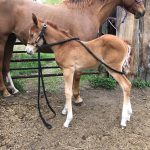
Cattleman’s Corner

Understanding feedlot margins
Market Update with Jerry Klassen: Much depends on having a risk management plan in place

Processing cattle with artificial intelligence
Machine learning is now part of high-tech livestock handling equipment

Putting a halter on a foal: Part 1
Horse Handling: Be gentle but firm in getting them use to halter and lead rope. Part 1 of a 4 part series on training foals

Crop diversity intended to beef up the soil
Proper rotation is part of developing sustainable farming operation

More than one way to get replacement cows
The general rule of an annual 10 per cent turnover in the cow herd may be an underestimate

Community mourns the loss of a longtime veterinarian
Rancher’s Diary: Dr. Cope served his clients for 44 years, working right up until he died

Miscellaneous health problems in calves
Animal Health: A little extra time spent checking newborn calves might help reduce losses

First-calf heifers need to be prepared for rebreeding
They need to calve in good condition and then be kept in good condition as they also continue to grow and nurse a calf

U.S. continues with lower beef production
Market Update: Feeder market is sending signals to increase heifer retention and herd expansion

Feed enough potassium in dairy lactation diets
Dairy Corner: There’s a balancing act between there being too much or not enough K


